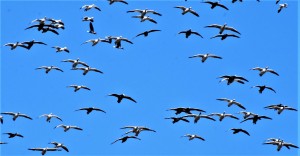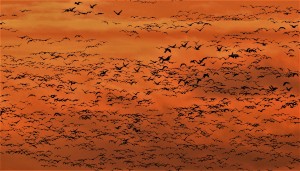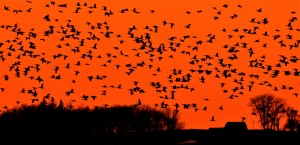Photography courtesy of Lowell Washburn, all rights reserved.
The spring migration of lesser snow geese represents one of the world’s most dramatic natural spectacles. An epic journey of sight and sound, the magnitude of the flight cannot be fully appreciated until witnessed firsthand. Six million strong, the white birds become a feathery spring blizzard as they marshal their legions to communally march more than three thousand miles toward ancestral subarctic breeding grounds.
Although the mass migration can currently be viewed statewide, the greatest concentrations occur in western Iowa as birds travel up the Missouri River. For those who’ve never been there, it’s a trip worth taking. Fast on the heels of a retreating snow line; high flying flocks cover the sky, forming a unique lacework pattern of overlapping lines and Vees that may stretch, uninterrupted, for 50 miles or more. When birds eventually descend to refuel, they cover stubble fields by the acre. Visible for miles, the vast concentrations really do look like “fields of snow” as tens of thousands of geese nosily compete for the same leftover kernels of corn.
But as awe-inspiring as it may be, the spring spectacle is not without consequence. During recent years, the white geese have become abundant to the point of severely impacting the quality of northern nesting areas. In an ongoing effort to stabilize and reduce populations, liberal spring hunting seasons have been allowed since 1999.
But in sharp contrast to the small flocks and naive birds of yesteryear, contemporary snow geese have become wary and challenging. They are, in fact, the most difficult of all waterfowl to successfully bring to bag. Many of the white birds have been traveling the flyways for ten or more years. During that time, they’ve seen it all and don’t mind passing their knowledge on to younger birds. Pursuing the geese provides human hunters with ample lessons in extreme humility as passing flocks pause to inspect — and then reject — perfectly positioned field spreads that literally contain hundreds of decoys which required hours of back breaking work to put in place.
There are those rarest of days, however, when everything clicks and clamoring snow geese throw caution to the winds and eagerly descend to the decoys like opening day teal. One such hunt occurred a few migrations ago on March 17th. I hadn’t seen a goose all day until about midmorning, when I spotted what resembled a large swarm of bees on the southern horizon. Sighting the decoys, the ‘swarm’ grew ever closer until I could clearly hear the terrier-like yelping of excited snow geese. Upon reaching the spread, the birds began an abrupt descent, piling in without so much as a single preliminary swing. I have no idea how many birds the flock actually contained; all I know is that it was huge. The closest geese were now landing within ten paces of where I sat; the combined volume of the shrill in-your-face honking was simply overwhelming. As I rose to fire, the sky seemed completely filled with nosily descending, legs hanging, cupped-up snow geese.
I had barely returned to my hide when I spotted a second, near identical goose flock approaching from the south. Spotting the decoys, the birds adjusted their course and came directly to the spread. Arriving overhead, the geese hit the brakes and just like the first group, began dropping straight in. Equally amazing was that after I had emptied my shotgun into the flock, the same birds immediately returned to make a second attempt at landing in the decoys. By the time it concluded, the day easily ranked as one of the most exciting waterfowl hunts of my life.
Exactly what made those normally impossible to fool geese behave in such an extraordinary manner is hard to say. On the surface, the day appeared to be an exact copy of the one before; a day when I had seen plenty of geese but never fired a single shot. I guess that some things will forever remain a mystery. One fact is certain though. Mornings like that are what keep snow goose hunters coming back for more.





 Tom Cope
Tom Cope Sue Wilkinson
Sue Wilkinson Susan Judkins Josten
Susan Judkins Josten Rudi Roeslein
Rudi Roeslein Elyssa McFarland
Elyssa McFarland Mark Langgin
Mark Langgin Adam Janke
Adam Janke Joe Henry
Joe Henry Kristin Ashenbrenner
Kristin Ashenbrenner Joe Wilkinson
Joe Wilkinson Dr. Tammy Mildenstein
Dr. Tammy Mildenstein Sean McMahon
Sean McMahon